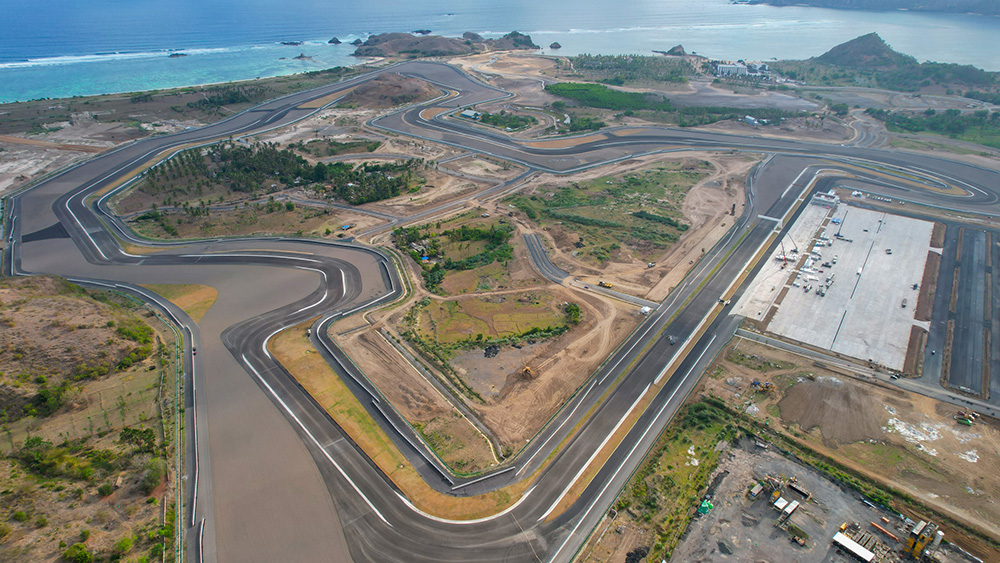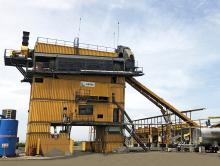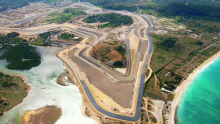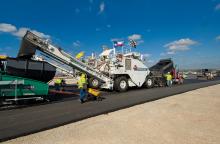
R3, an independent testing services business for roads, runways and racetracks, is the asphalt technical consultant for the Mandalika circuit. As such, the UK-based company is overseeing the design, methodology and construction of the racetrack surface. It advises the principal contractor and client, helping them achieve best-practice techniques and the highest level of quality control, says Campbell Waddell, the managing director of R3.
Because R3 was the technical consultant, it could specify Bomag equipment for the paving. “We had discussions with Bomag, approved their equipment and then specified their equipment right from the start,” he says. “Bomag rollers are well-known for their quality and being the best in the business. There was also good availability of stock and the willingness on behalf of Bomag itself to be involved in supporting the project from the start. These reasons are why we were keen that their equipment was used on site.”
The entire track was laid in echelon, all hot-to-hot joints, as R3 specified. “It is the only way to create the durability that allows the surface to handle the extreme forces of motorsport. Also, it is the only way to the tight surface smoothness as required, particularly important for MotoGP. We actually oversaw and monitored the paving process entirely by video link, the first time we have ever done that.”
R3 recommended Shell Bitumen’s high-performance Cariphalte Racetrack modified bitumen which has been adopted by many international race tracks, including the Formula One circuits of Yas Marina in Abu Dhabi, Marina Bay Street Circuit in Singapore, the Nürburgring in Germany and Ferrari’s own Fiorano test track in Italy.
There were three Lintec & Linnhoff asphalt mixing plants on site for the paving process. A large one - the Lintec CSD 3000 series with a maximum capacity of 240 tonnes per hour – was used only for the track surface and the feeding of the two Bomag pavers. The two smaller plants - Linnhoff TSD 1500 - were used for run-off areas and service roads.
R3 is heavily geared towards asphalt research and has a close relationship with the highways laboratory at Ulster University in Northern Ireland. Indeed, all three of the company directors hold PhDs in road engineering and asphalt from Ulster. Dr. Waddell obtained his PhD in 2019 having completed his thesis entitled The Grip of Motorsport Surfaces. Waddell’s five-year research project developed a system for testing motorsport surface characteristics using knowledge from the road and airport industries – something not done before. A system for quantifying and measuring surface characteristics including grip was developed.
Measuring surface characteristics such as micro-texture, macro-texture, surface roughness and enveloping offered an insight into factors influencing the tyre-surface interface. First-hand experience was gained from surface testing throughout the Formula One Singapore Grand Prix events since 2017 as well as at other Formula One and international circuits. While studying for his doctorate, Waddell worked for Findlay Irvine, the manufacturer of the GripTester, a continuous surface testing unit pulled behind a vehicle.
At the Mandalika circuit, the surface asphalt is designed to replicate characteristics that are similar to other racetracks that deliver desirable races, he explains. “In doing this, we have been able to maximise the use of local virgin materials, equipment and staff expertise. This has highlighted the potential of Indonesia to the world as well as reducing the environmental impact and cost of importing.”
R3’s team, says Campbell, put a lot of work into quality control at Mandalika. It is the first time that a stone mastic asphalt has been used on a racetrack in Indonesia and only a handful of times that it has been used on any road surface in the country. Aggregates used in SMA must be well shaped, resistant to crushing and sufficiently polish resistant. “We did much research to ensure that the Tau aggregates from Palu were suitable for a racing surface and that it was crushed to the correct shape and quality. It’s very hard stone but it also has a very nice green colour to it when the binder starts to wear away.”
When Waddell sets foot on the track this month for testing it will be for the first time since the pandemic started. As elsewhere, national and international COVID lockdowns and restrictions negated travel. R3 will be using its own RD-M1 scanner from Topcon as part of performance testing of the circuit this month and for an ongoing asset management programme. “We have a suite of bespoke, non-standard testing that we use from day one of a motorcycle racing track’s life to its end-of-life. The tests determine whether the surface characteristics are appropriate for racing and have the required characteristics of vehicle-tyre interaction.
“We also take the information and use it to model tyre wear and how the asphalt will wear over time. This knowledge can then be applied to track maintenance.” RS will be working in partnership with its sister company Roadgrip, also based in the UK and which is the operational partner for the Indonesian MotoGP motorcycle races.
Campbell hopes that R3’s efforts at the Indonesian track will open up other sporting markets in the region for the UK-based company. “Our work at Mandalika could be a lasting legacy for us.”








